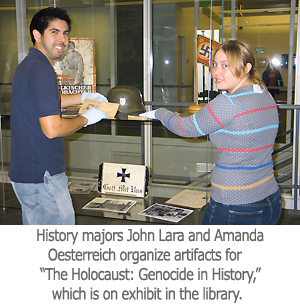

When
juniorsAmanda Oesterreich, Paul Diaz and John Lara enrolled in
History 190, they expected to devote the semester to an intense
researchproject. After all
Gregg Herken’sclass isn’t called Applied Research for no reason. What they didn’t expect, however, was the effect the project would have on them.
I thought it was just going to be a really big homework assignment, Diaz said. Instead, it became very emotional.
The students emotionally charged project is now a public exhibit in the
Leo & Dottie Kolligian Library.
The Holocaust: Genocide in Historywill be on display in the library until February.
These students elected to feature a painful and controversial topic: the systematic effort by Nazi Germany to exterminate the Jews of Europe during World War II, Herken said. That would be a challenging task for any curator, and it’s proven to be a valuable learning experience for these students.
According to the students, the value of the experience is directly related to the resources at their disposal, namely access to the private collection of World War II enthusiast Michael Akers. The husband of a UC Merced staffer, Akers volunteered to loan his collection to the university if there was ever interest in a Holocaust exhibit.
The Holocaust was an atrocious event in history that can’t be talked about enough, Akers said. If it’s not talked about, it will be forgotten.
Ensuring history is not forgotten by the general public is the goal of UC Merced’s history program. The students goal with this specific project was to use the Holocaust as a 20
th-century example of genocide, which continues today. Herken’s goal, as a former Smithsonian curator, was to see a fair and accurate depiction of a controversial topic in contemporary history. The Los Angeles Museum of Tolerance has also loaned items from its permanent collection to round out the university’s exhibit.
When creating an exhibit on such a sensitive topic, you have to be aware of what you’re communicating to those who view it, Herken said. You want to be accurate but not sensational.
That is something the students were cautious of, said Lara, who was responsible for the Third Reich portion of the exhibit. Oesterreich took charge of the parts of the exhibit related to prisoners and other genocides. Diaz’s contribution to the project is a six-and-a-half-minute video that provides an overview of the Holocaust. The video is on display across from the elevators on the third floor of the library and serves as an introduction to the exhibit as well.
When discussing the personal impact curating the exhibit had on her, Oesterreich echoed sentiments expressed by both Lara and Diaz.
It is unbelievable what humans will do to other humans, she said.






